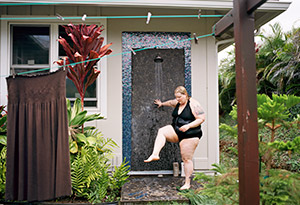Coming Into Focus: 3 Photos That Will Change How You Think About Your Body

Photo: Jen Davis, Courtesy of Lee Marks Fine Art
PAGE 2
So began a decadelong project, during which Davis shot hundreds of images of her body. "A lot of artists use self-portraits to transform into other identities. But my intention was to understand myself better. To articulate myself through the lens."
The photos are arresting. In one, Davis is fresh out of the shower, wrapped in a maroon towel, water droplets dotting her pale shoulders. In another, she is floating on her back in a concrete water tank, her limbs spread like starfish rays. Some shots convey her anxieties more directly: her fingers trying to button a too-small pair of pants; her eyes doleful as she lies awake in the toned arms of a sleeping man. Davis never imagined an audience when she began the project. Had she envisioned her photos hanging in museums and galleries, she wouldn't have been as bold, she says.
But it wasn't long before the powerfully raw images generated buzz in the photography world. Davis was accepted to the Yale University School of Art's Master of Fine Arts program. Galleries in France, Spain, and Italy exhibited her work. The New York Times Magazine published her photos. She won awards and grants, and colleges and museums invited her to lecture on her portrayals of beauty and sexuality.
And then, in the spring of 2011, during a photography residency in Syracuse, New York, while Davis was reviewing her portfolio—dozens of portraits blown up and hung on the wall—she was struck with the same feeling of horror she'd felt reading through her journals when she was 23. "In ten years, my body hadn't really changed, and I hadn't changed, either," she says. "The problem was that I was making myself vulnerable only for the camera. What I really wanted was to be vulnerable for another person."
That summer Davis underwent Lap-Band surgery, and after ten months, as this issue goes to press, she has lost 95 pounds—bringing her weight down to 174.
Despite the very real physical limitations created by a Lap-Band, patients who undergo the procedure must commit to eating healthily for long-term success. The failure rate, says Michael Hill, MD, of Adirondack Surgical Group, who has performed hundreds of these operations, is between 40 and 50 percent. Davis has not only adjusted to a new lifestyle but dedicated herself utterly to it. She has revamped her diet—eating mindfully (without distractions like the computer), avoiding simple carbohydrates, enjoying the feeling of filling up on nutritious foods like fruits and vegetables. She also hits the gym twice a week for cardio and weights, and does Pilates twice a week at home.
Top: Davis in 2011
Next: How Davis adapted to the changes
The photos are arresting. In one, Davis is fresh out of the shower, wrapped in a maroon towel, water droplets dotting her pale shoulders. In another, she is floating on her back in a concrete water tank, her limbs spread like starfish rays. Some shots convey her anxieties more directly: her fingers trying to button a too-small pair of pants; her eyes doleful as she lies awake in the toned arms of a sleeping man. Davis never imagined an audience when she began the project. Had she envisioned her photos hanging in museums and galleries, she wouldn't have been as bold, she says.
But it wasn't long before the powerfully raw images generated buzz in the photography world. Davis was accepted to the Yale University School of Art's Master of Fine Arts program. Galleries in France, Spain, and Italy exhibited her work. The New York Times Magazine published her photos. She won awards and grants, and colleges and museums invited her to lecture on her portrayals of beauty and sexuality.
And then, in the spring of 2011, during a photography residency in Syracuse, New York, while Davis was reviewing her portfolio—dozens of portraits blown up and hung on the wall—she was struck with the same feeling of horror she'd felt reading through her journals when she was 23. "In ten years, my body hadn't really changed, and I hadn't changed, either," she says. "The problem was that I was making myself vulnerable only for the camera. What I really wanted was to be vulnerable for another person."
That summer Davis underwent Lap-Band surgery, and after ten months, as this issue goes to press, she has lost 95 pounds—bringing her weight down to 174.
Despite the very real physical limitations created by a Lap-Band, patients who undergo the procedure must commit to eating healthily for long-term success. The failure rate, says Michael Hill, MD, of Adirondack Surgical Group, who has performed hundreds of these operations, is between 40 and 50 percent. Davis has not only adjusted to a new lifestyle but dedicated herself utterly to it. She has revamped her diet—eating mindfully (without distractions like the computer), avoiding simple carbohydrates, enjoying the feeling of filling up on nutritious foods like fruits and vegetables. She also hits the gym twice a week for cardio and weights, and does Pilates twice a week at home.
Top: Davis in 2011
Next: How Davis adapted to the changes



